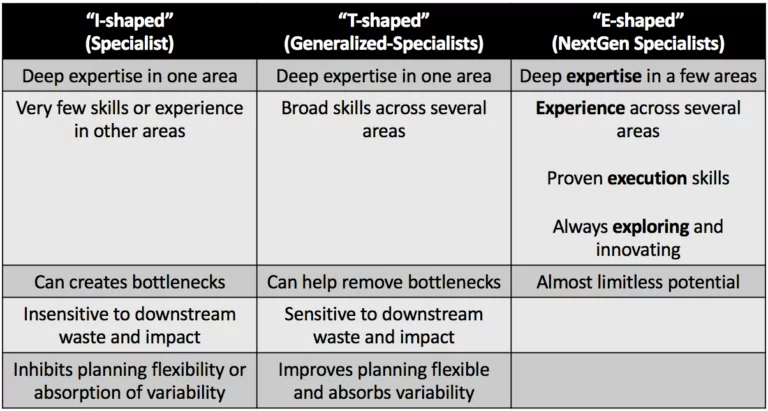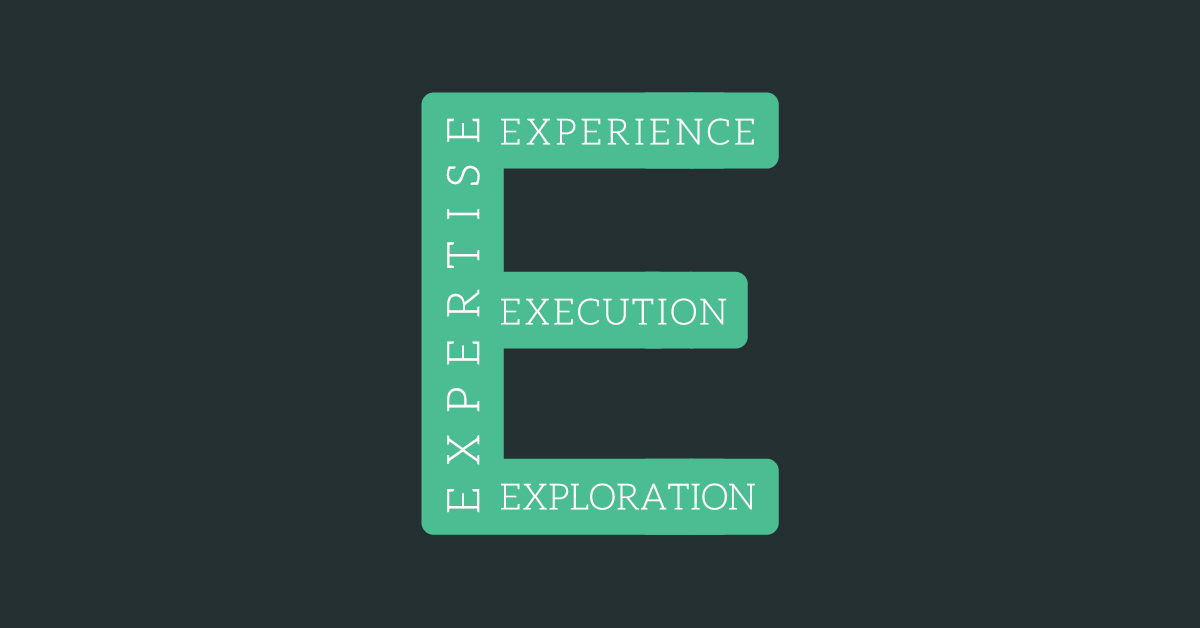Break Organizational Dependencies with an “E Shaped Person”
Organizations rely on an ever increasing number of technologies, so we often wind up with an increased number of specialists on staff. When departments over-specialize, they develop silos and increase the number of organizational dependencies. Everything begins to require multiple handoffs and things slow down. To counter silos and increase the flow of value moving through the system of delivery, we often encourage cross-functional teams with more “T-shaped” generalized-specialists.
Now, I’m currently reading The DevOps Handbook: How to Create World-Class Agility, Reliability, and Security in Technology Organizations [1]. For anyone who has read—or is currently reading—The Phoenix Project, read this book next. In addition to this, my colleague Jim Hayden recently pointed out a passage that got my attention. On page 86, there is a table that compares I-shaped, T-shaped, and E-shaped staff. That table is based on a 2012 blog post by Sarah DaVanzo. It inspired me to make a few changes to the table below and write this blog post.

I-shaped (Specialist)
The vertical stroke of the “I” is a depth of skill that allows someone to contribute to the creative process. They can be from any number of different fields to include: a developer, an architect, a tester, or an analyst. In organizations still utilizing a Waterfall model for application development, one can find specialists in functional phased groups.
In short, they create dependencies. These people are insensitive to downstream impacts and unwilling to help beyond their primary job. You may literally hear them say,
“That’s not my job.”
T-shaped (Generalized Specialist)
The term “T-shaped person” was coined by IDEO Chief Executive Tim Brown. When recruiting, IDEO assessed candidates based on both their breadth and depth of experience. In a 2010 interview with Chief Executive Magazine, Brown explained what a T-shaped person is:
The vertical stroke of the “T” is a depth of skill that allows them to contribute to the creative process. That can be from any number of different fields: an industrial designer, an architect, a social scientist, a business specialist or a mechanical engineer.
The horizontal stroke of the “T” is the disposition for collaboration across disciplines. It is composed of two things. First, empathy. It’s important because it allows people to imagine the problem from another perspective – to stand in somebody else’s shoes. Second, they tend to get very enthusiastic about other people’s disciplines, to the point that they may actually start to practice them. T-shaped people have both depth and breadth in their skills.
Since then, in the Agile community, the T-shaped staff member has become synonymous with a generalized specialist. You may hear someone is a developer by trade but is willing to roll up their sleeves when needed, to help test, clarify user story acceptance criteria, or fulfill some other team obligation. This will help remove bottlenecks and lessen the frequency of ridged handoffs. These people are sensitive to downstream impacts and willing to help beyond their primary job.
E-shaped (NextGen Specialist)
I note the term “E-shaped” was first referenced in the 2010 DaVanzo post. From there, I’m going to take some liberty to redefine it as the next generation (NextGen) of specialist for an Agile team.
The vertical stroke of the “E” is expertise in a few areas, to allow the specialist to contribute to the team. That can be from any number of different fields, just as we noted for the vertical stroke of the T-shaped people.
The first horizontal stroke of the “E” is experience. Not only do we want people with expertise in a few areas, but we also want experience in several areas.
The second horizontal stroke of the “E” is execution. We need a specialist with proven execution skills.
The last horizontal stroke of the “E” is exploration. These people should always be looking for ways to improve their craft or learn new skills.
If you can locate and employ these next-generation specialists, your team will have almost limitless potential.
[1] Kim, G., Willis, J., & Debois, P. (2016). The DevOps Handbook: How to create world-class agility, reliability, and security in technology organizations. United States: IT Revolution Press.



Comments (6)
Vasilij
Deep experts in multiple areas is wishful thinking. As the world is changing faster than ever, just maintaining expertise in one area is hard enough. More than one and it will consume most of the time just to keep up with all the updates.
In my professional life I met just a handful of guys that were good in just two areas. I do not think it is realistic to demand that from most team candidates.
As Peter Drucker said decades ago – “No institution can possibly survive if it needs geniuses or supermen to manage it. It must be organized in such a way as to be able to get along under a leadership composed of average human beings. “
Vasilij, thanks for the thoughtful comments. I’m just looking for expertise in a few areas. Let’s just say two or three. When you say multiple, I think three or more. My colleagues at LeadingAgile have deep expertise in several areas. So, I don’t think it’s too wishful to want it. Maybe the expertise could be in different programming languages or different database types. When looking for the E-shaped people, I wouldn’t necessarily demand all of those attributes of a candidate. Rather, I would keep my eye out for these attributes and be aware of their potential value to the team.
Regards,
Derek
Juan Ramon
I have worked with great I, T and E shaped people. But what has often been missed is the right mix of I, T and E shaped people in teams. The latter matters the most in my opinion.
adrian
where can i get more information about E-shape and T-shape professional?
As noted in the post, you can check out a 2010 post titled “Business Trend: “E-Shaped” People, Not “T-Shaped””
Dawid
There is something more important in E-shaped skilled people, not their expertise but:
“People (workers) today also need to be able to execute. As they say, ‘ideas are like noses, everyone has one.’ I’m tired of people coming to me with a great idea or invention, but with no clue how to bring it fruition. Real genius is being able to execute ideas. “
Cheers!
Dawid